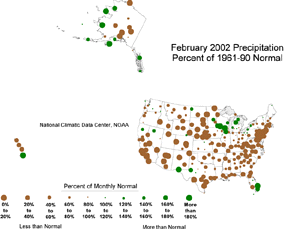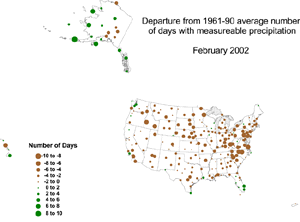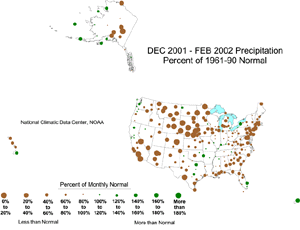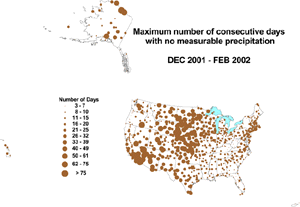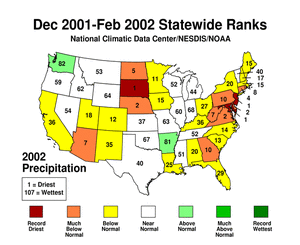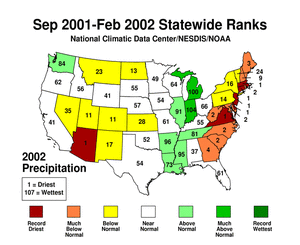National Overview
On the national scale,
|
 |
 |
Although some areas of the U.S. had above normal precipitation, many areas were very dry. February averaged much drier than normal when precipitation is integrated across the nation. Twelve of the last 30 months have averaged well below the normal, while only three averaged well above normal (see graph to right). National 2001-2002 precipitation ranks:
|
 |
Regional Overview
Winter storms that moved across the Pacific Northwest and northern Rockies brought beneficial snow and rain to some areas during February. However, the wet start to winter was interrupted on a regional basis, with long-term deficits still covering a large part of the western U.S.
Drought continued its stranglehold across the eastern seaboard, with extreme moisture deficits occurring in February from the mid-Atlantic coast into the Ohio Valley and Deep South.
Long-term deficits continued in parts of the southern Plains, while short-term deficits persisted during February in the northern Plains.
Parts of northern and southeast interior Alaska had a dry February, while mountain snowpack across much of the state continued below average. The primary stations in Hawaii were dry in the northern islands but wet on the Big Island.
This overall pattern is evident in the following indicators:
Two other drought-related monitoring tools are the Vegetation Health Index and the Keetch-Byram Drought Index:
|
Western U.S. Drought
| Winter storms that moved across the Pacific Northwest and northern Rockies brought beneficial snow and rain to some areas during February. However, on a regional basis, dryness during this month interrupted the wet start to winter in the Pacific Northwest (see graph below left) and continued a dry interruption for a second month across the West region (see graph below right). In the Southwest region, February marked the ninth consecutive month with near to much below-normal precipitation. |
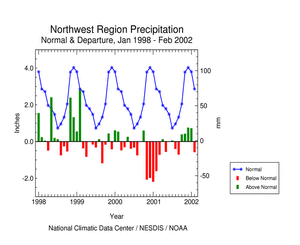 |
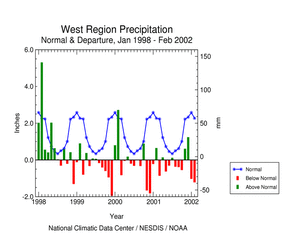 |
| The end-of-February mountain snowpack and snow water equivalent observations illustrated this regional pattern, with above-average values in the Pacific Northwest and below-average values across the rest of the Far West. The severe impact from last year's dry rainy season and, for the Southwest, this winter's dryness, is reflected in early March 2002 reservoir levels that were generally still below seasonal norms across the West. Highlights: |
|
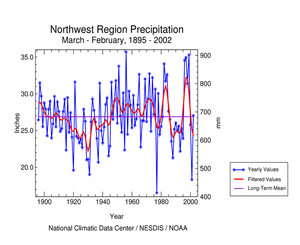 |
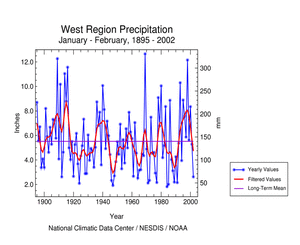 |
With a wet November-December and a dry January-February, this year's rainy season so far (November-February) has averaged near normal for the West region. Highlights:
|
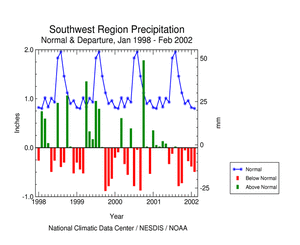 |
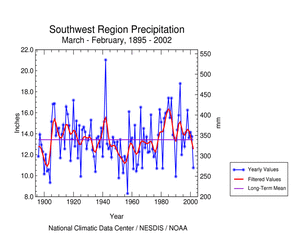 |
|
February marks the ninth consecutive month with near to much below-normal precipitation for the Southwest region (see graph above left). Winter is the dry season, but the prolonged below-normal precipitation has resulted in the 16th driest 12-month period (see graph above right).
Impacts from the dryness in this normally dry region include an increasing risk of wildfires and lowering reservoir levels. According to The Arizona Republic, parched lakes and reservoirs are nearing their lowest levels in half a century in some parts of drought-stricken Arizona, and a few have vanished as unusually dry conditions gripped the state for a fourth straight winter. |
|
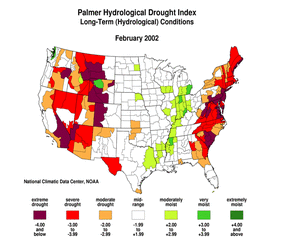 |
Severe to extreme drought conditions continued in the northern Rockies during February (see map to left). Wyoming and Montana had the 11th and 21st driest March-February on record in 2001-2002. The severity and rapid onset of the dryness resulted in statewide Palmer Drought Indices for these states that are comparable to the severity of the worst droughts of the last 100 years (see graphs below). |
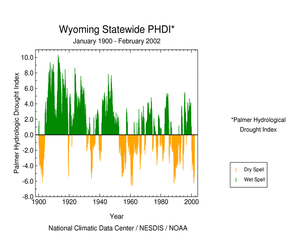 |
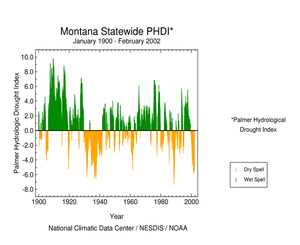 |
Central U.S. Drought
| February was unusually dry across parts of the northern and southern Great Plains and Ohio Valley. The Central and South regions had the seventh and 16th driest February on record, respectively. |
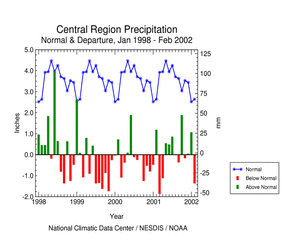 |
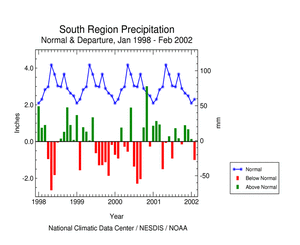 |
| For the West North Central region, February ranked as the 34th driest regionwide, although parts of the region were severely dry. The short-term dryness was most severe from Nebraska to northern Minnesota on the one-month to three-month time scales. South Dakota had the driest winter (December 2001-February 2002) on record, with Nebraska ranking second driest. On a longer time scale, the West North Central region had the tenth driest August-February on record in 2001-2002. |
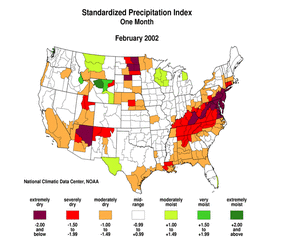 |
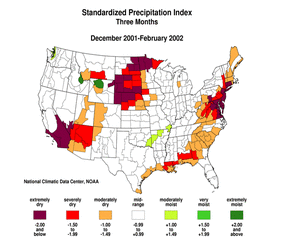 |
Eastern U.S. Drought
| February marked the fifth consecutive month with below to much below normal precipitation for the Northeast and Southeast regions. Severe to extreme drought extended all of the way down the east coast, from Maine to Georgia, resulting in significant impacts in many areas. By the end of the month, the threat of wildfires was high from the Carolinas to the eastern Great Lakes. |
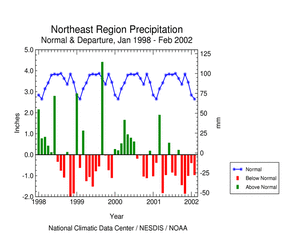 |
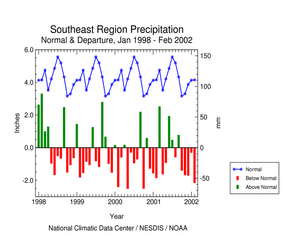 |
|
The long-term dryness this year in the Northeast region is comparable to the major Northeast drought of the 1960s for seasons from June-February to March-February (see table below right). When precipitation is integrated over the last five months, October 2001-February 2002 ranks as the second driest such period on record, following the record dry October-February of 1930-31 (see graph to right).
Some highlights: |
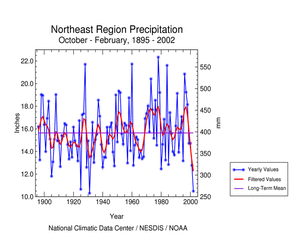 |
|
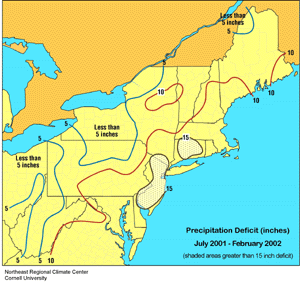 |
|
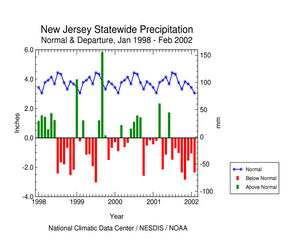
|
| Precipitation averaged across the Southeast region gave February 2002 a rank of 13th driest February on record. With the persistent dryness of the last five months, October 2001-February 2002 ranked as the third driest October-February on record (see graph below left). This marks the fourth consecutive year of drought in much of the Southeast. |
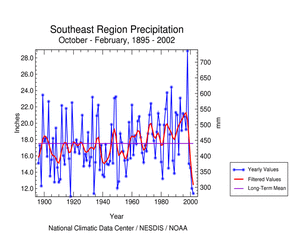 |
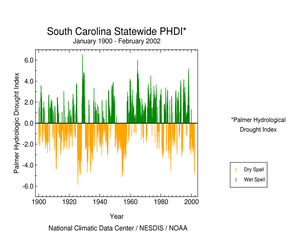 |
Highlights:
|
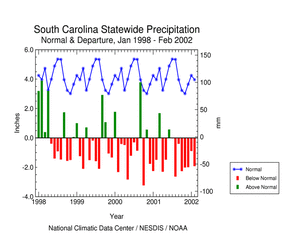
|
| The drought in the eastern U.S. affected much of the eastern seaboard, from the Appalachians to the coast, from Maine to northern Florida (see maps below). |
 |
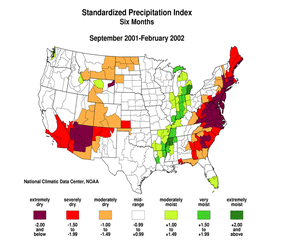 |
| This east coast drought region, as a whole, has experienced consistently drier than normal weather for the last five months. The seasons from November 2001-February 2002 back to August 2001-February 2002 are the driest such seasons on record. The current spell of dry weather, on a regional basis, can be traced back to May 1998 (see graph below left). The persistence of the dryness over the last four years, combined with the extreme amplification of the drought over the last five months, has resulted in a regionwide Palmer Hydrological Drought Index that is as severe as any for the last 60 years (see graph below right). |
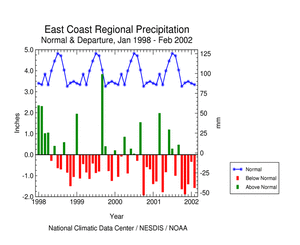 |
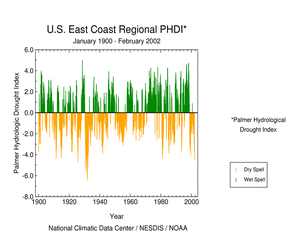 |

Additional Contacts:
Damage due to the drought has been summarized by NOAA and the Office of Global Programs in the Climatological Impacts section of the Climate Information Project. Crop impact information can be found at the USDA NASS (National Agricultural Statistics Service) and Weekly Weather and Crop Bulletin pages. Drought statements by local National Weather Service Offices can be found at the NWS Hydrologic Information Center. Drought threat assessments and other information can be found at NOAA's Drought Information Center. Additional drought information can be found at the National Drought Mitigation Center, the USDA's National Agricultural Library, the interim National Drought Council, and the NOAA Paleoclimatology Program. The following states have set up web pages detailing current drought conditions and/or their plans to handle drought emergencies:
For additional information on current and past wildfire seasons please see the National Interagency Fire Center web site or the U.S. Forest Service Fire and Aviation web site. NCDC's Drought Recovery Page shows the precipitation required to end or ameliorate droughts and the probability of receiving the required precipitation. Additional climate monitoring graphics can be found at the Climate Prediction Center's monitoring pages:
Drought conditions on the Canadian prairies can be found at the Agriculture and Agri-Food Canada Drought Watch page. |
 NOAA's National Centers for Environmental Information
NOAA's National Centers for Environmental Information
